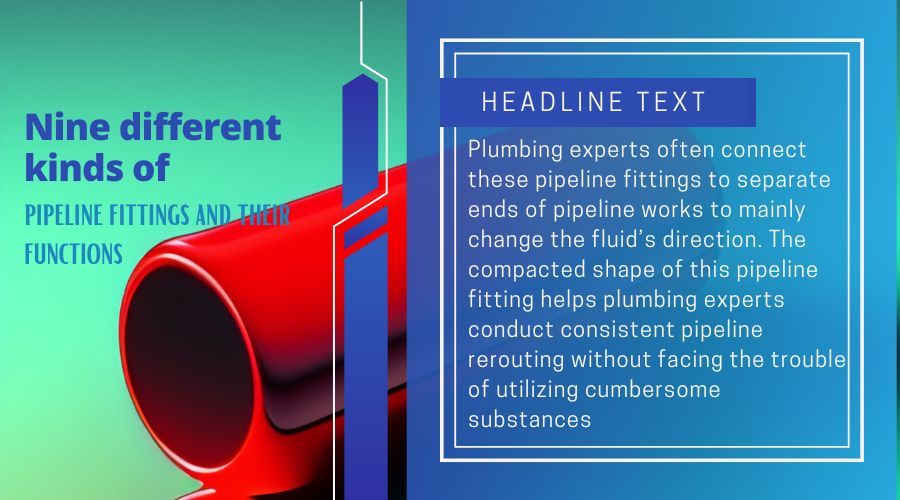
Plumbing professionals often need pipeline fittings for every plumbing and piping system they utilize in commercial and industrial applications. Pipeline fittings need pipes to be installed or joined in the proper place and, where possible, closed or terminated. Pipeline fitting suppliers sell pipeline fittings in various sizes and shapes. Building pipe fittings could be costly and time-consuming for plumbing professionals. Thus, they must buy affordable pipe fittings in bulk from a well-known pipe fitting supplier.
All the various tubes or pipes require their own fitting, but all pipeline fittings utilize their most usual characteristics. Pipeline assemblies are available everywhere, where plumbing suppliers offer plumbing supplies for sale. Plumbing professionals commonly use pipeline fittings for various plumbing and hydraulic operations applications. Manufacturers make many different kinds of pipeline fittings from a range of substances. These include Adapters, tee fittings, plugs, bushings, reducers, flanges, coupling, Cross-type, and elbows. This blog section discusses the various kinds of pipeline fittings below.
Plumbing experts often connect these pipeline fittings to separate ends of pipeline works to mainly change the fluid’s direction. The compacted shape of this pipeline fitting helps plumbing experts conduct consistent pipeline rerouting without facing the trouble of utilizing cumbersome substances. These pipeline fittings come in various angles- forty-five or ninety-degree angles to be precise. The applications of each two are only slightly different in that ninety degrees elbow fittings are often used to join hoses, water pumps, and valves.

Contrary to elbow pipeline fittings with just a couple of openings, a cross-type pipeline fitting has four openings, each located in separate directions. Depending on the type of usage, a cross-type might either have a single outlet or vice-versa and three inlets. Arguably, openings of the cross-type pipeline fitting’s most common type have the same diameter, but there might be some examples where this is not necessarily the case- especially for a decreasing cross-type fitting. Cross-types normally need to tolerate a greater level of liquid pressure in separate directions than elbow pipe fittings. Sometimes, plumbing professionals reinforce them with other substances to avert breakage.
Though pipeline makers see that their pipelines are sturdy enough to circumvent damage and leaks, there are other guarantees. There are several options that plumbing professionals can exercise to remediate this type of problem- one is to replace the pipeline itself or to fix a coupling to an impacted region. According to their name, plumbing professionals utilize coupling fittings to join a couple of pipelines together to expand the pipeline range or protect against leakage. The couple of ends of a coupling commonly feature the same diameter. Still, there are also examples wherein the other end has a smaller diameter to provide space for a change in pipeline sizing.
Like cross-type fittings, tee pipe fittings feature both outlets and inlets. The significant difference is that the tee fittings do not feature four openings but three. A couple of outlets are vertical to the inlet of the tee fitting. Plumbing professionals commonly utilize this kind of pipe fittings to merge the flow of liquids from two outlets. Due to this purpose, the part must also be able to grasp on its own because of the pressure generated by the fluid’s flow. As such, manufacturers make tee fittings by utilizing a broad range of substances such as rubber, brass, copper, cast iron, and stainless steel.

Compared to the previous kinds of fittings, plugs do not help redirect or combine the movement of fluids. Instead, they are placed at the pipelines’ ends to stop the flow during a repair or pipeline maintenance process. Gas fittings, hydraulic systems, and other types of coolant systems might make use of plugs. Depending on the pipeline opening’s shape, plugs might also come in circular, slotted, square or hexagonal sockets to fit the pipeline. They usually feature high corrosion-resistance finishing to safeguard the substance and avert it from being subject to the destruction caused by weathering and oxidation.
Like couplings, joining pipelines which come in various sizes is also bushings’ function. They are small and do not occupy much space, permitting for an abrupt and convenient process of decreasing diameter size without virtually several drawbacks. Bushings might be not-threaded or threaded in their outer and inner spaces, but once this this is dependent on the sealing needs of the pipeline. Threads give the impression that some pipeline fittings bear for the assembly’s purposes.

There are two major types of reducers, namely eccentric and concentric. The shape of concentric reducers are like cone upon production, and plumbing professionals use them to produce a decline in a fitting diameter in a smooth manner on the same axis. Eccentric reducers do not feature a common axis, rather, the smaller outlet has been manufactured to be equivalent to a connecting pipeline. Plumbing professionals apply concentric reducers to steeply installed piping work. Contrary to that, eccentric reducer fittings are utilized in horizontal uses because of the fitting’s flat side.
Another type of pipeline fittings are flanges which plumbing professionals to combine pipelines, pumps and valves to expand the network and run of the pipe installation. These pipe fittings make repair and upkeeping much simpler due to their structure which lets plumbing professionals conveniently detach them with equipment and instruments like screwdrivers. For consistency, plumbing experts choose flanges with respect to the type of the pipeline material. If the pipeline is composed of stainless steel, plumbing experts use a stainless steel flange. The same applies to steel and iron pipelines.

Plumbing experts link connections to pipelines to either increase their connections’ duration or if pipelines do not feature proper ends. These pipeline fittings permit either female or male threading of the pipeline’s ends as needed. It makes communication unlike pipelines without the requirement for elaborate set-up. Plumbing professionals mostly use them for tubing composed of copper and polyvinyl chloride.